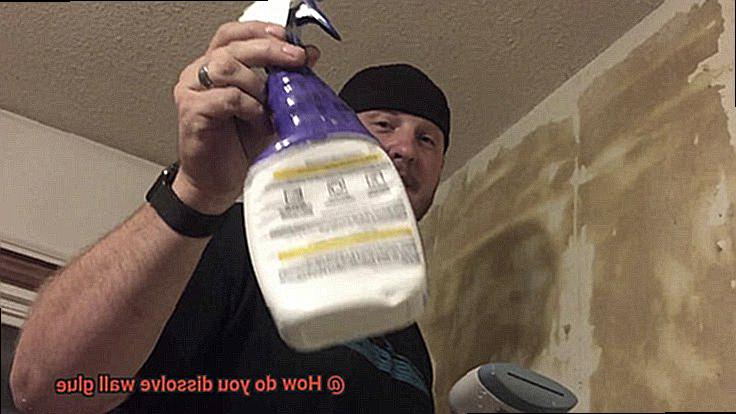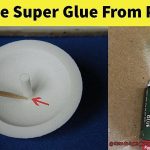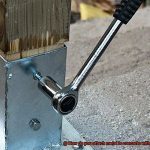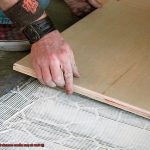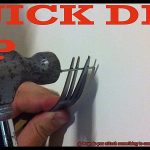Have you ever found yourself in a sticky situation, desperately trying to remove wall glue? Whether you’re dealing with remnants of a previous renovation or an unexpected discovery, we understand the frustration. But fear not. In this all-inclusive guide, we’ll spill the beans on how to effortlessly dissolve wall glue, leaving your walls flawless once again.
Imagine this: you’ve just moved into your dream home, ready to unleash your creativity and transform each room. But as you peel back layers of old wallpaper or stickers, you’re met with a daunting challenge – stubborn adhesive glue clinging to your walls. It’s enough to send shivers down your spine. But don’t panic; we’ve got your back.
With our expert advice at your disposal, you’ll gain the knowledge and confidence to tackle this task head-on. We’ll dive into the factors that contribute to wall glue’s tenacity, explore why it’s so tricky to remove, and finally reveal foolproof techniques for dissolving this sticky situation.
In the upcoming sections, prepare yourself for a range of effective solutions – from everyday household heroes like vinegar and baking soda to specialized adhesive removers. And don’t worry; we won’t leave you hanging. We’ll walk you through step-by-step instructions on how to apply these remedies like a pro, ensuring a hassle-free experience.
Get ready for an eye-opening journey as we uncover the surprising science behind adhesives, unveil time-saving tips and tricks, and harness the incredible power of natural solvents. By the end of this guide, you’ll be armed with all the know-how needed to dissolve wall glue like a true expert.
Say goodbye to pesky wall glue and hello to perfectly pristine walls once again. Let’s embark on this transformative journey together as we unlock the secrets of effortless glue removal.
What Is Wall Glue?
Contents
- 1 What Is Wall Glue?
- 2 Heat Method for Dissolving Wall Glue
- 3 Chemical Solvents for Dissolving Wall Glue
- 4 Mechanical Methods for Dissolving Wall Glue
- 5 Factors to Consider When Choosing a Method
- 6 Safety Considerations When Working with Solvents or Chemicals
- 7 Pros and Cons of Different Methods
- 8 Conclusion
Wall glue, also referred to as wallpaper adhesive or wallpaper paste, is a remarkable substance that plays a crucial role in the installation of wallpaper. It possesses unique characteristics that allow it to form a strong and lasting bond between the wallpaper and the wall surface. In this article, we will delve into the captivating world of wall glue, exploring its composition, workability, bonding strength, and additional properties.
Composition:
Wall glue is primarily a water-based adhesive that contains a captivating blend of ingredients. These include cellulose derivatives, starches, resins, and preservatives. Together, they create a mesmerizing concoction that provides a sticky and durable quality, ensuring the wallpaper adheres securely to the wall.
Workability:
One of the enchanting features of wall glue is its ability to remain workable for an extended period. Unlike other adhesives that dry out quickly, wall glue maintains its malleable state once mixed with water. This magical characteristic allows for easy application and adjustment of the wallpaper during installation, ensuring precise alignment and positioning.
Bonding Strength:
The true power of wall glue lies in its exceptional bonding strength. It forms an unbreakable connection between the wallpaper and the wall surface, preventing any peeling or detachment. This formidable durability is particularly important in environments with high humidity or moisture, as it effectively resists the damaging effects of moisture on the wallpaper.
Additional Properties:
To add to its allure, different types of wall glue may possess additional properties tailored to specific needs and preferences. Some variations exhibit resistance to mold growth, providing an extra layer of protection in areas prone to moisture accumulation. Others showcase enhanced adhesion on particular surfaces, ensuring a flawless installation on even the most challenging walls.
Heat Method for Dissolving Wall Glue
Wall glue can be a formidable adversary when it comes to transforming your walls. But fear not, for within the realm of the heat method lies a mesmerizing solution. Journey with me as we explore the captivating world of dissolving wall glue through the power of heat. So grab your trusty hairdryer and prepare to embark on this enchanting adventure.
Chapter 1: Testing the Waters
Before we delve into the magic of heat, it’s crucial to ensure that your wall surface can withstand its transformative powers. Certain materials, such as delicate paint or vinyl wallpaper, may crumble under excessive heat. To avoid any unfortunate mishaps, always conduct a small inconspicuous area test before applying heat to the entire wall.
Chapter 2: The Mesmerizing Dance of the Hairdryer
Behold the hairdryer – not just a tool for drying locks, but a key player in our quest. Set it to its highest heat setting and direct its scorching breath towards a small section of the stubborn wall glue. Keep a few inches of distance between the hairdryer and the surface, allowing the heat to gracefully caress and soften the adhesive. Watch as the glue surrenders to the bewitching warmth.
Chapter 3: The Art of Gentle Scraping
As the glue succumbs to the heat’s enchantment, it’s time to unveil your secret weapons – putty knives or plastic scrapers. With finesse and care, gently scrape away the softened glue, being mindful not to exert excessive force that could harm your precious walls. Our aim is to banish the glue, not leave behind scars of battle.
Chapter 4: Dividing and Conquering
To ensure a thorough dissolution of every last trace of wall glue, it is wise to divide and conquer. Work in small sections, traversing the wall with a sense of purpose. Apply heat and scrape away the softened glue as though performing a delicate dance, leaving no stubborn residue untouched. This meticulous approach guarantees walls that are pristine and ready for their next magical transformation.
Chemical Solvents for Dissolving Wall Glue
Step into the realm of enchantment as we unravel the secrets of dissolving wall glue. In this captivating chapter, we will explore the magical powers of chemical solvents, delving into their ability to break down and eradicate stubborn adhesives. Prepare to be spellbound as we unveil an array of potent elixirs at your disposal.
Acetone: Unleashing the Sorcerer’s Solution
First on our list is the mighty sorcerer’s solution – acetone. This powerful solvent, known for its presence in nail polish removers, possesses an awe-inspiring ability to dismantle various adhesives, including wall glue. Like a flickering flame, acetone swiftly breaks down adhesive properties, leaving behind a pristine canvas for your next artistic endeavor. However, wield this sorcerer’s potion with caution, for it dances dangerously close to flames and sparks.
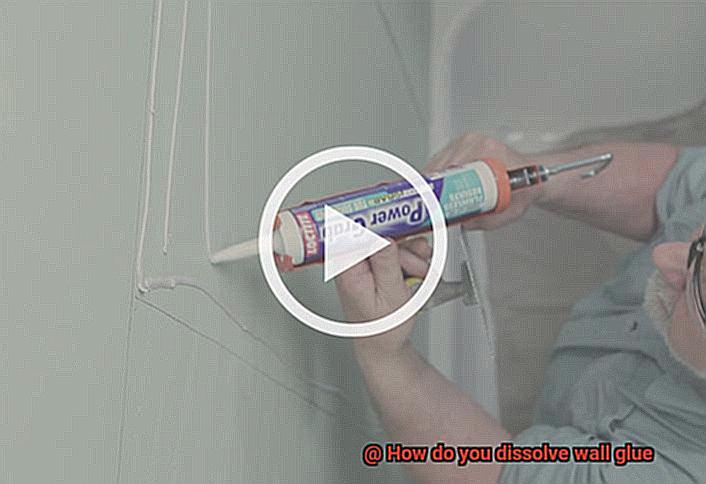
Isopropyl Alcohol: The Whispering Wizard
Next, we encounter the gentle yet effective whispering wizard – isopropyl alcohol. Commonly found as rubbing alcohol in every household, this mystical concoction can be easily summoned from pharmacies or supermarkets. Its secret lies in its ability to soften the adhesive properties of wall glue, rendering removal effortless. Let this elixir grace the affected area and witness its enchanting magic. Then, armed with a scraper or a soft cloth, gently banish the softened glue from the surface with a wave of your hand.
White Vinegar: Nature’s Melody
Behold the wonders of nature as we embrace white vinegar – nature’s melodic solvent. Infused with acetic acid, this enchanting elixir effortlessly breaks down adhesive properties without harming the environment or your health. Apply it directly to the affected area and allow it to harmonize with the glue for several minutes. Then, with the grace of a skilled dancer, gently remove the softened adhesive using a scraper or soft cloth. Nature’s melody will leave your walls gleaming, ready for their next magical transformation.
Mechanical Methods for Dissolving Wall Glue
Get ready to witness a collection of techniques that will effortlessly erase those stubborn adhesive remnants, leaving your walls primed for your next masterpiece. So, gather your tools, don your expert caps, and let’s dive into the fascinating world of breaking down wall glue.
Scraping Away the Sticky Situation:
Let’s start with the timeless art of scraping. Armed with a trusty putty knife or scraper, you’ll apply just the right amount of pressure while carefully gliding it along the surface of the wall. The goal? To remove that pesky glue without causing any damage. Precision is key here, so take your time and let those sticky bonds crumble beneath your skilled hands.
Sanding Your Way to Smoothness:
For those smaller areas or thin layers of glue, sanding is a method that delivers remarkable results. Grab your sandpaper or sanding block and gently rub away at the glue until it dissolves before your eyes. This technique requires finesse, so be patient and let the friction work its magic. However, keep in mind that larger or thicker amounts may require a different approach.
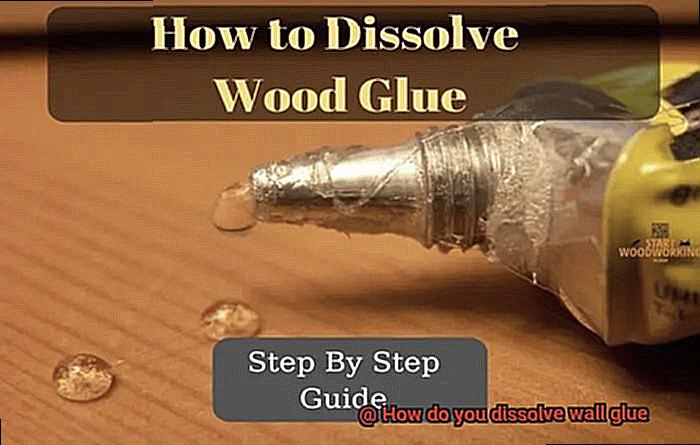
Harnessing the Power of Heat:
Prepare to heat things up with our next mechanical method – literally. Grab a heat gun or hairdryer and unleash high heat upon that glue. Watch as it softens before your eyes, making it easy to scrape off or wipe away. But remember, caution is key. Too much heat can damage your walls or leave you with unwanted burns.
Soaking Glue Away:
Sometimes, all you need is a little water-based magic to dissolve that stubborn wall glue. Wet a cloth or sponge with warm water and gently lay it over the affected area. Let the water work its way into the adhesive, gradually dissolving it. Once the glue has succumbed to the soaking power, grab your trusty scraper or cloth and wipe away the residue. Voila. A clean canvas awaits.
Factors to Consider When Choosing a Method
Before we dive in, let’s recap the exciting techniques we explored earlier.
From scraping and sanding to harnessing the power of heat and using water-based magic, we’ve covered a range of methods that will leave your walls ready for their next masterpiece. Now, let’s explore the factors you should consider when choosing a method to dissolve wall glue.
First, let’s talk about the type of glue. Different glues have different chemical compositions, meaning they require specific solvents or techniques to effectively dissolve. Water-based glues can usually be dissolved with water or mild detergent solutions. On the other hand, solvent-based glues may need stronger solvents like acetone or mineral spirits. So, it’s crucial to identify the type of glue you’re dealing with before selecting your method.
Next up is the surface material. Different materials react differently to solvents, and some solvents can cause damage or discoloration. To avoid any unintended consequences, choose a method that is safe for the specific surface material you’re working on. You don’t want to end up with a discolored or damaged wall after all your hard work.
Now, let’s prioritize safety precautions. Some solvents can be flammable or emit harmful fumes, so always follow proper safety guidelines. Work in a well-ventilated area and protect your skin and eyes by wearing gloves and eyewear. Safety goggles and gloves are not just fashion statements; they’re essential for protecting yourself during this daring mission.
Moving on to ease of application. Some methods require specialized tools or equipment, while others are more accessible and straightforward. Choose a method that matches your skill level and the resources you have available. We don’t want you feeling overwhelmed or ill-equipped for battle.
And finally, consider the time and effort required. Removing wall glue can be a time-consuming task, so assess how much time and effort you’re willing to invest. Some methods may require multiple applications or longer soaking times, while others offer quicker results. Align your chosen method with your schedule and preferences to ensure a successful outcome without feeling like you’re trapped in glue forever.
Safety Considerations When Working with Solvents or Chemicals
Working with solvents or chemicals can be exhilarating, but safety should always be your top priority. Don’t let the excitement of dissolving that stubborn wall glue overshadow the importance of taking precautions. Let’s dive into some key safety considerations that will ensure a smooth and hazard-free experience:
- Ventilation: Take a breath of fresh air, quite literally. Adequate ventilation is crucial when working with solvents or chemicals. Those fumes can pack a punch if inhaled in high concentrations. So, open those windows wide, turn on some fans, or consider using a respirator or mask if you’re working in a confined space. Let the fresh air flow and keep those harmful vapors at bay.
- Personal Protective Equipment (PPE): Protect yourself like a pro. When dealing with solvents or chemicals, don’t forget to gear up with the right personal protective equipment. Slip on chemical-resistant gloves to shield your hands, put on some goggles to safeguard your eyes, and wrap yourself in a lab coat or protective clothing to prevent direct contact with those potentially harmful substances. Safety suits you.
- Read and Follow Instructions: Don’t skip this essential step – read and understand the instructions provided by the manufacturer. Each solvent or chemical has its own unique properties and safety precautions, so it’s crucial to know what you’re working with. Pay close attention to any warnings, storage instructions, and proper disposal methods mentioned on the product label. Knowledge is power.
- Storage and Handling: Treat your solvents and chemicals like VIPs – Very Important Products. Proper storage and handling are paramount to prevent accidents or exposure. Keep these substances in a well-ventilated area, away from direct sunlight, heat sources, and incompatible materials. And remember, they’re not for kids or pets to play with. Store them securely out of reach, ensuring their containers have tight lids. Safety under lock and key.
- Fire Safety: Let’s extinguish any potential fire hazards. Many solvents used for dissolving adhesives are highly flammable, so fire safety should be taken seriously. Keep a fire extinguisher nearby, specially designed for flammable liquids. And please, no smoking or open flames anywhere near these substances. Let’s keep the heat where it belongs – far away from danger.
Pros and Cons of Different Methods
Today, we’re going to explore the thrilling world of dissolving wall glue and uncover the pros and cons of different methods. Get ready for a room makeover that will leave your friends in awe.
Let’s start with the classic method of applying heat. Imagine yourself wielding a hairdryer or a heat gun, ready to soften that adhesive and make it easier to remove. The pros? It’s quick and effective, giving you a speedy victory over that glue. But be warned. Heat can be a double-edged sword. If you’re not careful, it can unleash its fiery wrath on your walls or surrounding materials. Proceed with caution, my friend, and follow the safety guidelines like a seasoned pro.
Now, let’s turn our attention to solvents and adhesive removers. These magical potions are tailor-made to dissolve adhesives, and you can find them at your local hardware store. The pros? They are highly effective in removing glue without causing any harm to your precious walls or surrounding materials. No casualties here. However, don’t let their enchanting powers blind you to their potential downsides. Some solvents may have strong odors or contain harsh chemicals that could make your nose wrinkle. So, make sure you work in a well-ventilated area, detective, and follow the manufacturer’s instructions like it’s a matter of life or death.
But wait, nature lovers. There’s a natural alternative for you – vinegar and lemon juice. Harness the power of these humble substances to break down that wall glue. The pros? They are safe to use and can work wonders in their own right. Plus, they won’t harm the environment like some chemical-laden solvents might. However, fair warning – nature takes its time. These natural alternatives may require more patience as they may take longer to work, especially on stubborn or old glue. So, if you’re in a rush, you might want to consider other options.
Conclusion
In conclusion, removing wall glue doesn’t have to be a sticky situation. With the right know-how and clever techniques, you can effortlessly dissolve that stubborn adhesive and bring your walls back to their former glory. Throughout this comprehensive guide, we’ve explored a range of methods for tackling this task.
The heat method offers a swift and effective solution by harnessing the power of a hairdryer or heat gun to gently soften the adhesive. However, caution must be exercised to avoid any unintended damage to your precious walls or surrounding materials.
For those looking for a chemical approach, solvents like acetone, isopropyl alcohol, and white vinegar provide powerful options for breaking down even the most tenacious glues. These readily available solutions can be applied with ease, but it’s important to follow safety guidelines and consider any potential odors or harsh chemicals involved.
If you prefer a hands-on approach, mechanical methods such as scraping, sanding, and soaking can also work wonders in removing wall glue. Each technique demands precision and patience to achieve a clean finish without causing any harm.
When selecting your preferred method of attack, take into account factors like the type of glue you’re dealing with, the surface material involved, necessary safety precautions, ease of application, and time required for completion. It’s essential to identify the specific adhesive at hand and choose an appropriate method accordingly.
Lastly – but most importantly – always prioritize safety when working with solvents or chemicals. Ensure adequate ventilation is in place along with personal protective equipment (PPE), carefully read all instructions provided by manufacturers, store and handle these substances properly, and have fire safety measures on standby. A hazard-free experience is key.
So, don’t let wall glue hold you back from achieving your vision for your home.

